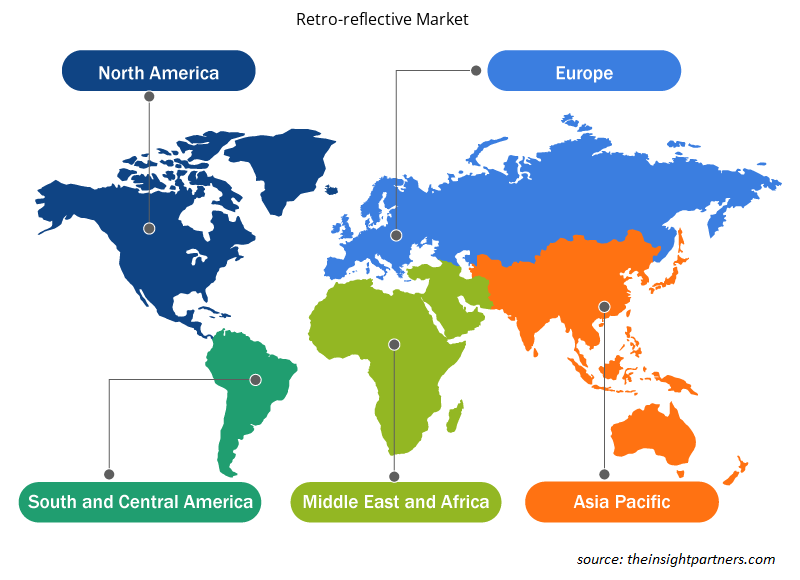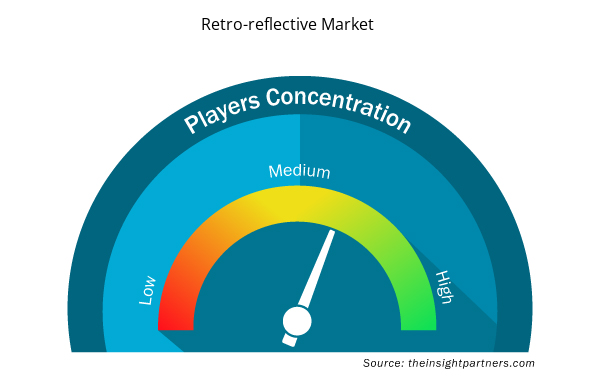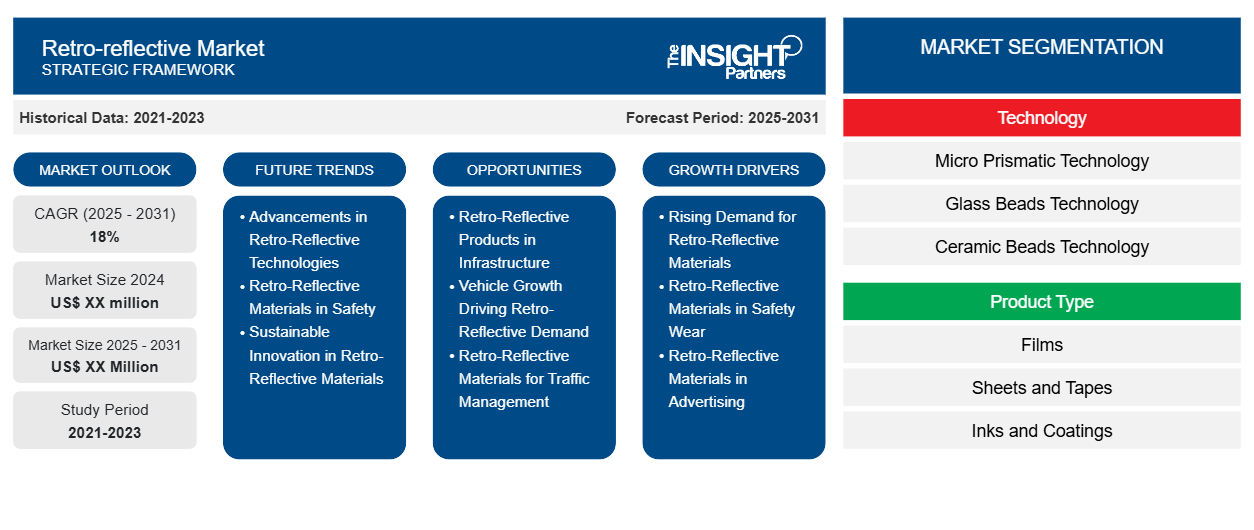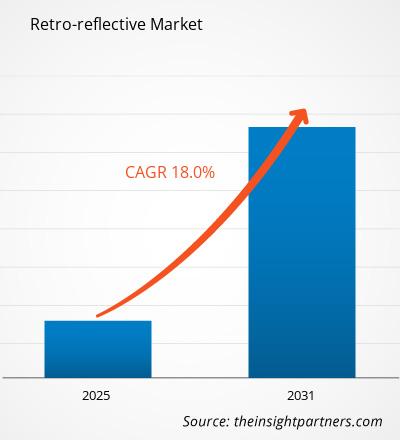Es wird erwartet, dass der Markt für retroreflektierende Produkte von 2024 bis 2031 eine durchschnittliche jährliche Wachstumsrate (CAGR) von 18 % verzeichnet, wobei die Marktgröße von XX Millionen US-Dollar im Jahr 2024 auf XX Millionen US-Dollar im Jahr 2031 anwachsen wird.
Der Markt für retroreflektierende Materialien umfasst Analysen nach Technologie (Mikroprismentechnologie, Glasperlentechnologie und Keramikperlentechnologie), Produkttyp (Folien, Platten und Bänder, Tinten und Beschichtungen und andere), Anwendung (Verkehrskontrolle, Sicherheitsbekleidung, Automobil, Industrie und andere) und Geografie (Nordamerika, Europa, Asien-Pazifik, Naher Osten und Afrika sowie Süd- und Mittelamerika). Der globale Markt für retroreflektierende Materialien verzeichnet schätzungsweise eine durchschnittliche jährliche Wachstumsrate von 17,7 %. Das Wachstumspotenzial des Automobilsektors in Entwicklungsländern und wachsende Bau- und Verkehrssicherheitsaktivitäten werden den Markt für retroreflektierende Materialien voraussichtlich ankurbeln.
Zweck des Berichts
Der Bericht „Retroreflektierender Markt“ von The Insight Partners zielt darauf ab, die gegenwärtige Landschaft und das zukünftige Wachstum sowie die wichtigsten treibenden Faktoren, Herausforderungen und Chancen zu beschreiben. Dies wird verschiedenen Geschäftspartnern Einblicke geben, wie zum Beispiel:
- Technologieanbieter/-hersteller: Um die sich entwickelnde Marktdynamik zu verstehen und die potenziellen Wachstumschancen zu kennen, damit sie fundierte strategische Entscheidungen treffen können.
- Investoren: Durchführung einer umfassenden Trendanalyse hinsichtlich der Marktwachstumsrate, der finanziellen Marktprognosen und der Chancen entlang der Wertschöpfungskette.
- Regulierungsbehörden: Zur Regulierung von Richtlinien und Überwachungsaktivitäten auf dem Markt mit dem Ziel, Missbrauch zu minimieren, das Vertrauen der Anleger zu bewahren und die Integrität und Stabilität des Marktes aufrechtzuerhalten.
Retroreflektierende Marktsegmentierung
Technologie
- Mikroprismatische Technologie
- Glasperlen-Technologie
- Keramikperlen-Technologie
Produkttyp
- Filme
- Platten und Bänder
- Tinten und Beschichtungen
- Sonstiges
Anwendung
- Verkehrssteuerung
- Sicherheitsbekleidung
- Automobilindustrie
- Industrie
- Sonstiges
Geographie
- Nordamerika
- Europa
- Asien-Pazifik
- Süd- und Mittelamerika
- Naher Osten und Afrika
Passen Sie diesen Bericht Ihren Anforderungen an
Sie erhalten kostenlose Anpassungen an jedem Bericht, einschließlich Teilen dieses Berichts oder einer Analyse auf Länderebene, eines Excel-Datenpakets sowie tolle Angebote und Rabatte für Start-ups und Universitäten.
- Holen Sie sich die wichtigsten Markttrends aus diesem Bericht.Dieses KOSTENLOSE Beispiel umfasst eine Datenanalyse von Markttrends bis hin zu Schätzungen und Prognosen.
Retroreflektierende Marktwachstumstreiber
- Steigende Nachfrage nach retroreflektierenden Materialien: Die immer strengeren Verkehrssicherheitsvorschriften weltweit treiben die Nachfrage nach retroreflektierenden Materialien in die Höhe. Retroreflektierende Materialien sorgen für bessere Sichtbarkeit bei Nacht und sorgen dafür, dass die Zahl der Verkehrstoten oder Todesfälle auf der Straße sinkt. Eine zunehmende Besorgnis über Sicherheitsstandards für Verkehrsschilder, Fahrzeuge und Arbeitskleidung garantiert ebenfalls ein stetiges Wachstum auf dem Markt für retroreflektierende Materialien.
- Retroreflektierende Materialien in Sicherheitskleidung: Weitere Bedenken wie die Sicherheit am Arbeitsplatz, insbesondere in riskanten Umgebungen, haben zur Verwendung retroreflektierender Materialien bei der Herstellung von Schutzkleidung geführt. Die zunehmende Konstruktion oder Einführung von gut sichtbarer Sicherheitsausrüstung in der Industrie, im Bergbau oder in der Logistik führt zu einer hohen Nachfrage nach retroreflektierenden Stoffen, Bändern und Kleidungsstücken.
- Retroreflektierende Materialien in der Werbung: Retroreflektierende Materialien werden häufig im Marketing und in der Außenwerbung für Anzeigen und Schilder verwendet, damit sie auch bei schwachem Licht gut sichtbar sind. Da Bereiche für den rund um die Uhr geöffneten Einzelhandel, belebte Stadtgebiete und sogar Außenwerbung immer zahlreicher werden, wird der Bedarf an retroreflektierenden Werbeschildern für die Sichtbarkeit bei Nacht unerlässlich und schafft so eine erhöhte Nachfrage im Werbesektor.
Retroreflektierende Markttrends für die Zukunft
- Fortschritte bei retroreflektierenden Technologien: Die Weiterentwicklung retroreflektierender Technologien wird stark von einer Vielzahl von Faktoren beeinflusst, wie z. B. verbesserten Glasperlen, besseren Mikroprismen-Retroreflektoren und abriebfesten Beschichtungen. All diese technologischen Fortschritte sorgen für eine bessere Leistung und viel länger anhaltende retroreflektierende Materialien in den Bereichen Transport, Sicherheit und Werbung.
- Retroreflektierende Materialien für mehr Sicherheit: Retroreflektierende Materialien werden in der Luftfahrt- und Schifffahrtsindustrie verwendet, um Bereiche zu markieren, in denen Sicherheitsmaßnahmen erforderlich sind. Dazu gehören beispielsweise Landebahnmarkierungen, Navigationszeichen und Rettungsausrüstung. Der globale Ausbau der Transportnetze und zunehmende Vorschriften hinsichtlich verbesserter Sicherheitsstandards waren Schlüsselfaktoren, die den Einsatz retroreflektierender Materialien beschleunigt haben.
- Nachhaltige Innovation bei retroreflektierenden Materialien: Mit der steigenden Nachfrage nach einer umweltfreundlicheren Produktion gibt es einen großen Impuls für die Entwicklung umweltfreundlicher retroreflektierender Materialien. Innovationen bei recycelbaren und umweltschonenden retroreflektierenden Beschichtungen gelten als Treiber für ein verstärktes Marktwachstum, da Unternehmen und Branchen nach umweltfreundlicheren Lösungen suchen, die dennoch ein sehr hohes Maß an Sicherheit und Sichtbarkeit gewährleisten.
Retroreflektierende Marktchancen
- Retroreflektierende Produkte in der Infrastruktur: Aufgrund der rasanten Entwicklung der Infrastruktur in allen Regionen, auch in Entwicklungsländern, erfreuen sich retroreflektierende Produkte nicht nur bei Verkehrsschildern und Barrieren, sondern auch bei Sicherheitskleidung zunehmender Beliebtheit. Große Bau- und Autobahnprojekte erfordern viel mehr Sichtbarkeitslösungen und erhöhen den Bedarf an retroreflektierenden Produkten in Städten und ländlichen Gebieten.
- Fahrzeugwachstum treibt Nachfrage nach retroreflektierenden Produkten: Die zunehmende Fahrzeugproduktion und der Straßenverkehr auf der ganzen Welt erfordern eine bessere Sichtbarkeit von Fahrbahnmarkierungen und -schildern. Hier trägt eine hohe Sichtbarkeit bei Nacht für Fahrer und Fußgänger zum Wachstum des Marktes bei, was sich positiv auf Transport- und Automobilanwendungen auswirkt.
- Retroreflektierende Materialien für das Verkehrsmanagement: Angesichts der Notwendigkeit eines effizienten Verkehrsmanagementsystems in verkehrsreichen städtischen Gebieten ist es daher notwendig, retroreflektierendes Material zu verwenden. Derartige beschichtete Verkehrsschilder, Fahrbahnmarkierungen und Barrieren aus retroreflektierenden Materialien verbessern den Verkehrsfluss, tragen zur Unfallreduzierung bei und erleichtern die sichere Vernetzung von Straßen.
Retroreflektierende regionale Markteinblicke
Die regionalen Trends und Faktoren, die den Markt für retroreflektierende Produkte im Prognosezeitraum beeinflussen, wurden von den Analysten von Insight Partners ausführlich erläutert. In diesem Abschnitt werden auch die Marktsegmente und die Geografie für retroreflektierende Produkte in Nordamerika, Europa, im asiatisch-pazifischen Raum, im Nahen Osten und Afrika sowie in Süd- und Mittelamerika erörtert.

- Holen Sie sich die regionalspezifischen Daten für den retroreflektierenden Markt
Umfang des retroreflektierenden Marktberichts
| Berichtsattribut | Details |
|---|---|
| Marktgröße im Jahr 2024 | XX Millionen US-Dollar |
| Marktgröße bis 2031 | XX Millionen US-Dollar |
| Globale CAGR (2025 - 2031) | 18 % |
| Historische Daten | 2021-2023 |
| Prognosezeitraum | 2025–2031 |
| Abgedeckte Segmente | Nach Technologie
|
| Abgedeckte Regionen und Länder | Nordamerika
|
| Marktführer und wichtige Unternehmensprofile |
|
Retroreflektierte Marktteilnehmerdichte: Deren Einfluss auf die Geschäftsdynamik verstehen
Der Markt für retroreflektierende Produkte wächst rasant, angetrieben durch die steigende Nachfrage der Endnutzer aufgrund von Faktoren wie sich entwickelnden Verbraucherpräferenzen, technologischen Fortschritten und einem größeren Bewusstsein für die Vorteile des Produkts. Mit steigender Nachfrage erweitern Unternehmen ihr Angebot, entwickeln Innovationen, um die Bedürfnisse der Verbraucher zu erfüllen, und nutzen neue Trends, was das Marktwachstum weiter ankurbelt.
Die Marktteilnehmerdichte bezieht sich auf die Verteilung der Firmen oder Unternehmen, die in einem bestimmten Markt oder einer bestimmten Branche tätig sind. Sie gibt an, wie viele Wettbewerber (Marktteilnehmer) in einem bestimmten Marktraum im Verhältnis zu seiner Größe oder seinem gesamten Marktwert präsent sind.
Die wichtigsten auf dem Markt für retroreflektierende Produkte tätigen Unternehmen sind:
- 3M Unternehmen
- American & Efird LLC
- Asiatische Farben GmbH
- Avery Dennison Corporation
- Changzhou Hua R Sheng Reflektierendes Material Co., Ltd.
Haftungsausschluss : Die oben aufgeführten Unternehmen sind nicht in einer bestimmten Reihenfolge aufgeführt.

- Überblick über die wichtigsten Akteure auf dem retroreflektierenden Markt
Wichtige Verkaufsargumente
- Umfassende Abdeckung: Der Bericht deckt die Analyse von Produkten, Dienstleistungen, Typen und Endbenutzern des Retroreflektierenden Marktes umfassend ab und bietet einen ganzheitlichen Überblick.
- Expertenanalyse: Der Bericht basiert auf dem umfassenden Verständnis von Branchenexperten und Analysten.
- Aktuelle Informationen: Der Bericht stellt durch die Abdeckung aktueller Informationen und Datentrends Geschäftsrelevanz sicher.
- Anpassungsoptionen: Dieser Bericht kann angepasst werden, um den spezifischen Kundenanforderungen gerecht zu werden und die Geschäftsstrategien optimal anzupassen.
Der Forschungsbericht zum Markt für retroreflektierende Materialien kann daher dabei helfen, die Branchensituation und Wachstumsaussichten zu entschlüsseln und zu verstehen. Obwohl es einige berechtigte Bedenken geben kann, überwiegen die allgemeinen Vorteile dieses Berichts tendenziell die Nachteile.
- Historische Analyse (2 Jahre), Basisjahr, Prognose (7 Jahre) mit CAGR
- PEST- und SWOT-Analyse
- Marktgröße Wert/Volumen – Global, Regional, Land
- Branche und Wettbewerbsumfeld
- Excel-Datensatz


- Batter and Breader Premixes Market
- Parking Management Market
- Lymphedema Treatment Market
- Aircraft MRO Market
- Legal Case Management Software Market
- Underwater Connector Market
- Electronic Signature Software Market
- Aerospace Forging Market
- Molecular Diagnostics Market
- Pressure Vessel Composite Materials Market

Report Coverage
Revenue forecast, Company Analysis, Industry landscape, Growth factors, and Trends

Segment Covered
This text is related
to segments covered.

Regional Scope
North America, Europe, Asia Pacific, Middle East & Africa, South & Central America

Country Scope
This text is related
to country scope.
Häufig gestellte Fragen
The North America market is expected to account for the highest CAGR during the forecast period owing to the growing construction industry in the region.
The films and sheets product type segment accounted for the largest market share in 2023
3M Company, ORAFOL, Asian Paints PPG, Reflomax, Avery Dennison, Nippon Carbide Industries, Taiwan Paiho Ltd, Changzhou Hua Sheng, DM reflective material co ltd, and Honeywell International Inc are some of the key players in the market.
Growing infrastructure projects is a key driver in the market
The Retro-reflective Market is estimated to witness a CAGR of 18% from 2023 to 2031
Technological developments is an emerging trend in the market.
Trends and growth analysis reports related to Chemicals and Materials : READ MORE..
The List of Companies
- 3M Company
- American & Efird LLC
- Asian Paints Limited
- Avery Dennison Corporation
- Changzhou Hua R Sheng Reflective Material Co., Ltd.
- Coats Group plc
- Nippon Carbide Industries Co., Inc.
- ORAFOL Europe GmbH
- Paiho Group
- REFLOMAX Co., Ltd.
The Insight Partners performs research in 4 major stages: Data Collection & Secondary Research, Primary Research, Data Analysis and Data Triangulation & Final Review.
- Data Collection and Secondary Research:
As a market research and consulting firm operating from a decade, we have published and advised several client across the globe. First step for any study will start with an assessment of currently available data and insights from existing reports. Further, historical and current market information is collected from Investor Presentations, Annual Reports, SEC Filings, etc., and other information related to company’s performance and market positioning are gathered from Paid Databases (Factiva, Hoovers, and Reuters) and various other publications available in public domain.
Several associations trade associates, technical forums, institutes, societies and organization are accessed to gain technical as well as market related insights through their publications such as research papers, blogs and press releases related to the studies are referred to get cues about the market. Further, white papers, journals, magazines, and other news articles published in last 3 years are scrutinized and analyzed to understand the current market trends.
- Primary Research:
The primarily interview analysis comprise of data obtained from industry participants interview and answers to survey questions gathered by in-house primary team.
For primary research, interviews are conducted with industry experts/CEOs/Marketing Managers/VPs/Subject Matter Experts from both demand and supply side to get a 360-degree view of the market. The primary team conducts several interviews based on the complexity of the markets to understand the various market trends and dynamics which makes research more credible and precise.
A typical research interview fulfils the following functions:
- Provides first-hand information on the market size, market trends, growth trends, competitive landscape, and outlook
- Validates and strengthens in-house secondary research findings
- Develops the analysis team’s expertise and market understanding
Primary research involves email interactions and telephone interviews for each market, category, segment, and sub-segment across geographies. The participants who typically take part in such a process include, but are not limited to:
- Industry participants: VPs, business development managers, market intelligence managers and national sales managers
- Outside experts: Valuation experts, research analysts and key opinion leaders specializing in the electronics and semiconductor industry.
Below is the breakup of our primary respondents by company, designation, and region:

Once we receive the confirmation from primary research sources or primary respondents, we finalize the base year market estimation and forecast the data as per the macroeconomic and microeconomic factors assessed during data collection.
- Data Analysis:
Once data is validated through both secondary as well as primary respondents, we finalize the market estimations by hypothesis formulation and factor analysis at regional and country level.
- Macro-Economic Factor Analysis:
We analyse macroeconomic indicators such the gross domestic product (GDP), increase in the demand for goods and services across industries, technological advancement, regional economic growth, governmental policies, the influence of COVID-19, PEST analysis, and other aspects. This analysis aids in setting benchmarks for various nations/regions and approximating market splits. Additionally, the general trend of the aforementioned components aid in determining the market's development possibilities.
- Country Level Data:
Various factors that are especially aligned to the country are taken into account to determine the market size for a certain area and country, including the presence of vendors, such as headquarters and offices, the country's GDP, demand patterns, and industry growth. To comprehend the market dynamics for the nation, a number of growth variables, inhibitors, application areas, and current market trends are researched. The aforementioned elements aid in determining the country's overall market's growth potential.
- Company Profile:
The “Table of Contents” is formulated by listing and analyzing more than 25 - 30 companies operating in the market ecosystem across geographies. However, we profile only 10 companies as a standard practice in our syndicate reports. These 10 companies comprise leading, emerging, and regional players. Nonetheless, our analysis is not restricted to the 10 listed companies, we also analyze other companies present in the market to develop a holistic view and understand the prevailing trends. The “Company Profiles” section in the report covers key facts, business description, products & services, financial information, SWOT analysis, and key developments. The financial information presented is extracted from the annual reports and official documents of the publicly listed companies. Upon collecting the information for the sections of respective companies, we verify them via various primary sources and then compile the data in respective company profiles. The company level information helps us in deriving the base number as well as in forecasting the market size.
- Developing Base Number:
Aggregation of sales statistics (2020-2022) and macro-economic factor, and other secondary and primary research insights are utilized to arrive at base number and related market shares for 2022. The data gaps are identified in this step and relevant market data is analyzed, collected from paid primary interviews or databases. On finalizing the base year market size, forecasts are developed on the basis of macro-economic, industry and market growth factors and company level analysis.
- Data Triangulation and Final Review:
The market findings and base year market size calculations are validated from supply as well as demand side. Demand side validations are based on macro-economic factor analysis and benchmarks for respective regions and countries. In case of supply side validations, revenues of major companies are estimated (in case not available) based on industry benchmark, approximate number of employees, product portfolio, and primary interviews revenues are gathered. Further revenue from target product/service segment is assessed to avoid overshooting of market statistics. In case of heavy deviations between supply and demand side values, all thes steps are repeated to achieve synchronization.
We follow an iterative model, wherein we share our research findings with Subject Matter Experts (SME’s) and Key Opinion Leaders (KOLs) until consensus view of the market is not formulated – this model negates any drastic deviation in the opinions of experts. Only validated and universally acceptable research findings are quoted in our reports.
We have important check points that we use to validate our research findings – which we call – data triangulation, where we validate the information, we generate from secondary sources with primary interviews and then we re-validate with our internal data bases and Subject matter experts. This comprehensive model enables us to deliver high quality, reliable data in shortest possible time.


 Holen Sie sich ein kostenloses Muster für diesen Bericht
Holen Sie sich ein kostenloses Muster für diesen Bericht